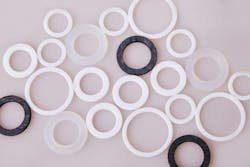Make it Standard: How Stocking Standard Products Benefits both OEM and Supplier
Why is it important for suppliers to have standard products on hand? Seal suppliers tend to focus on custom products as they typically involve the most recent technology and provide a competitive advantage. Likewise, original equipment manufacturers (OEMs) often keep their sights on the latest and most innovative solutions their suppliers bring to the table.
However, OEMs also look for the fastest and most accessible source for standard products when they need them. Seal suppliers who can provide timely solutions to a customer’s problem with standard products, such as an O-ring, are often the ones who have a readily available stock of parts. A sealing partner that can offer custom solutions as well as standard products for an OEM prove to be the most valuable.
Advantage of Stocking O-rings
Often overlooked compared to more complex sealing technologies, suppliers might not keep a wide range of standard O-rings in stock. However, those that do have a major advantage when it comes to service. Following supply chain disruptions caused by political unrest, workforce shortages and natural disasters, customers increasingly focus on supply assurance.
READ MORE: Spotlight on Sealing Solutions for Fluid Power and Off-Highway
According to a 2022 analysis from Deloitte, the second most cited operational concern for manufacturers was suppliers who are struggling to meet demand. If companies don’t keep standard products on the shelf, another company does. Stocking them makes for a more competitive supplier. Repair shops are often small mom-and-pop operations that don’t realize they need standard O-rings until disassembling the defective unit, and they assume they will be available at any time.
Other Advantages to Stocking Standard Products
Committing to a stock of standard products can also generate new business for a seal supplier. For example, an OEM came to Trelleborg with a drawing for an O-ring in an industry standard material and asked for an equivalent. In this instance, we had the corresponding O-ring size in an equivalent material in stock and provided an immediate quote, as well as a quick turnaround to supply the product. Stock availability fostered a new relationship with the customer.
To take this concept a step further, seal suppliers can increase their service level even more and offer customers advanced planning for regular shipments of standard products. If a customer routinely purchases larger diameter standard O-rings that are less likely to be in stock, the customer’s commitment to buy a certain quantity of O-rings every month enables suppliers to ensure their availability.
Stocking Standard Products for Efficiency, Speed and Quality
Utilizing industry standard design profiles and sizes ensures that designers and end-users can easily and quickly specify sealing components, allowing the reuse of hardware designs and contributing to cost savings. Standardization also supports ease of repair, refurbishment and reuse through readily available replacement parts.
READ MORE: What’s the Difference Between O-Rings and Guide Rings?
Trelleborg used its technical expertise and standard products to help Lion Hydraulics improve productivity and in-house assembly times by switching to a standard Dualseal for their static seals on hydraulic cylinders.
The hydraulics company was using a two-piece O-ring and back-up ring combination when Trelleborg introduced them to the single-piece standard polyurethane (PU) Dualseal, which retrofitted their existing groove. In addition to saving assembly and production time, the switch to the PU Dualseal also alleviated quality issues that had been experienced in the field with their nitrile rubber back-up ring.
About the Author

Scott Christensen
Americas Purchasing Manager, Trelleborg Sealing Solutions
Scott Christensen is Americas purchasing manager at Trelleborg Sealing Solutions. He has worked his entire career in supply chain management focusing on customer centric solutions that drive sales growth through smarter purchasing practices. Christensen earned a bachelor’s degree from Brigham Young University with an emphasis in supply chain management and an MBA from Utah Valley University.
